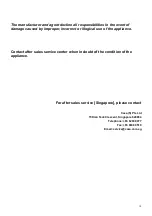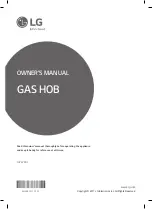
12
CHOOSING SUITABLE SURROUNDINGS
The room where the gas appliance is to be installed must have a natural flow of air so that the gas can burn.
The flow of air must come directly from one or more openings made in the out-side walls with a free area of at
least 100c
㎡
. If the appliance does not have a no-flame safety device this opening must have an area of at
least 200c
㎡
.
The openings should be near the floor and preferably on the side opposite the exhaust for combustion
products and must be so made that they cannot be blocked from either the outside or the inside. When these
openings cannot be made the necessary air can come from an adjacent room which is ventilated as required,
as long as it is not a bedroom or a dangerous area. In this case the kitchen door must allow the passage of the
air.
DISCHARGING PRODUCTS OF COMBUSTION
Extractor hoods connected directly to the outside must be provided, to allow the products of combustion of the
gas appliance to be discharged (fig.8). If this is not possible, an electric fan may be used, attached to the
external wall or the window; the fan should have a capacity to circulate air at an hourly rate of 3-5 times the
total volume of the kitchen (fig.9). The fan can only be installed if the room has suitable vents to allow air to
enter, as described under the heading “choosing suitable surroundings”
SETTLING UP THE HOB FOR INSTALLATION
Every cooker top is provided with a set of tabs for fitting to the fixture panel with thickness from 3 to 4 cm and a
seal with adhesive on one side.
-Remove burners and grids.
-Turn the cooker top over and rest the glass side on a cloth.
- Place the battery in the battery compartment.
-Apply the self-adhesive seal “G” as illustrated in fig.10.
-Slot the cooker top into the unit and position.
-Position the cooker top in the recess and secure by means of the brackets as shown in fig.11 (for 3 or 4
cm thick work top).
Содержание EFH 7622 HM VGB (PUB)
Страница 3: ...3 IMPORTANT WARNING ON THE GLASS ...




































